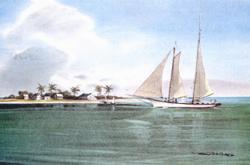|
|
|

|
|
Photo courtesy of the
Florida Division of Historical Resources.
|
Indian Key was first occupied by Native Indians around 700 years ago. At this time, there were camps or small hamlets on Upper and Lower Matecumbe and Teatable Keys in addition to Indian Key. The inhabitants settled here, in part, to take advantage of the excellent fishing in the relatively deep channels between the islands.
Archaeological evidence on the island indicates that Indian Key was visited by the Spanish during the 16th century. Deep water close to shore provided a location where ships could anchor while crews went ashore for water. Early maps give various names to Indian Key, including "Matanca" and "Matanzas." On some maps the islands in the area are simply referred to as "the Matecumbes."
During the 17th and 18th centuries it seems likely that Indian Key was visited by pirates, but evidence for this is extremely sketchy. Beginning in the early 19th century, Indian Key began to emerge as a center for commercial activity. A trading post was located on the island in the 1820 and during the 1830s the key became a home port for a fleet of wreckers. Wrecking, the practice of providing aid and securing profit from the salvage of vessels wrecked on the reef, was a major industry in the Florida Keys. In 1836, Indian Key was made the first county seat of Dade County. At this time the island had a hotel, warehouse, store, and blacksmith shop, and had more than 50 residents. In 1840, near the end of the Second Seminole War, the island was attacked and burned by Spanish-speaking Indians.
Although the island never fully recovered from the attack of 1840, in subsequent years it was used by the military as the site for a hospital, and later became a staging area for the construction of Carysfort and Alligator Lights. During the 1870s a boatyard was located on Indian Key, and the island was used as a depot for the construction of Henry Flagler's railroad to Key West at the beginning of the 20th century.
|
Find out more:
Florida Keys Internet Guide
Eyster, Irving R. and Darlene Brown. Indian Key. Privately published, Long Key, Fla., 1976.
Baker, Henry. "Archaeological Investigations at Indian Key, Florida," Florida Division of Archives, History and Records Management, Bureau of Historic Sites and Properties, Miscellaneous Project Report Series, No. 7, December 1973.
Schene, Michael G. "History of Indian Key," Florida Division of Archives, History and Records Management, Bureau of Historic Sites and Properties, Miscellaneous Project Report Series, No. 8, December 1973.
|
|






